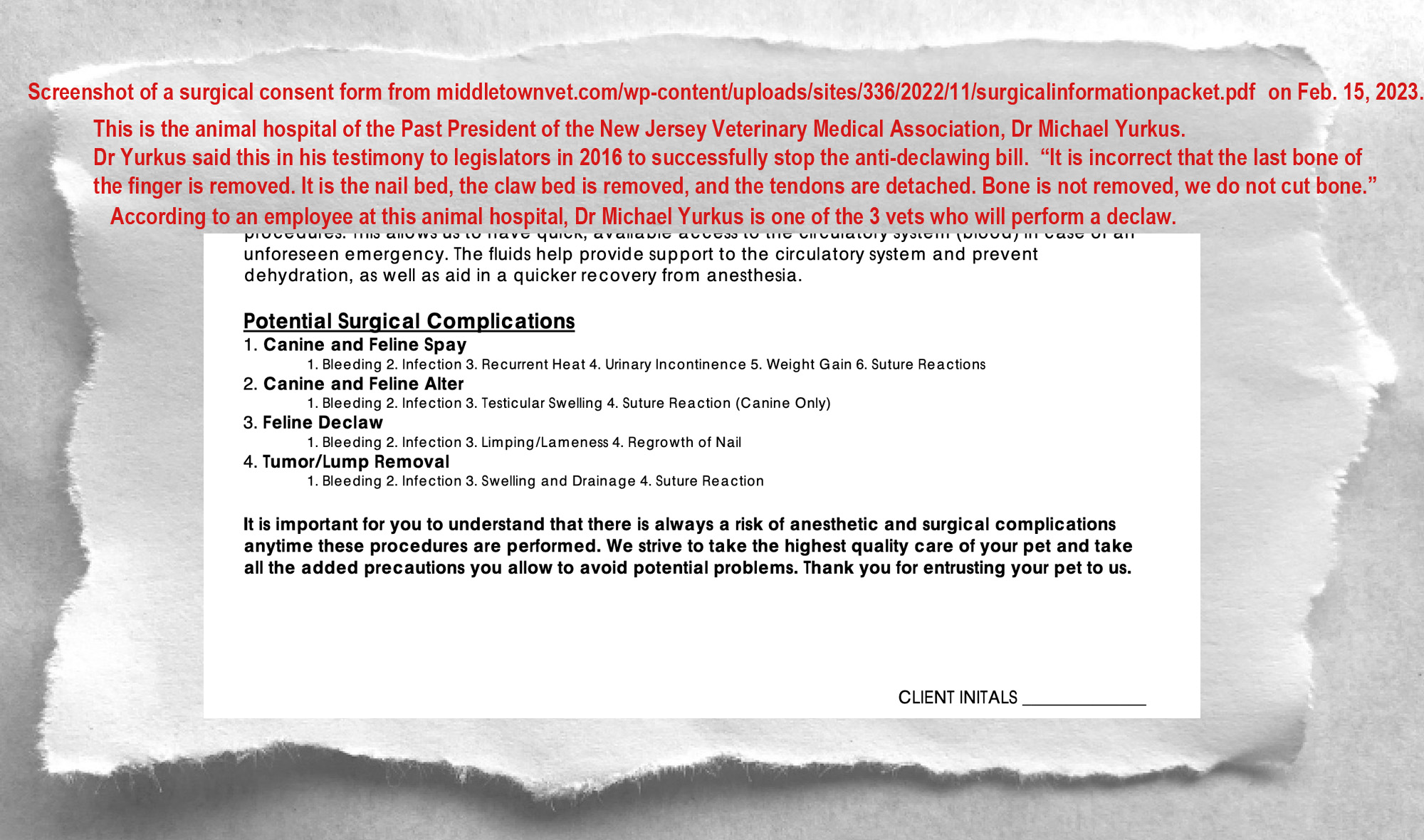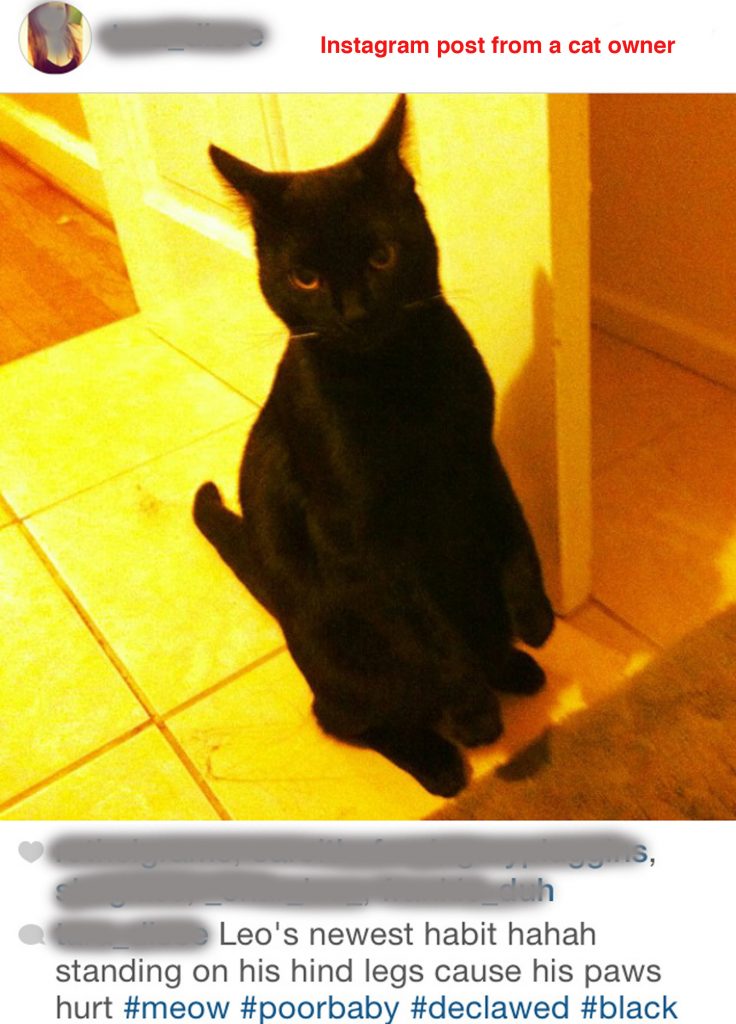February 2023 Update.
Dr Michael Yurkus, 2017-18 President of the New Jersey Veterinary Medical Association, is still declawing cats according to an employee at his hospital, Middletown Animal Hospital.
An employee at this hospital said that declawing is a very painful elective procedure like if a human is getting plastic surgery. Researcher asked if it is ok for a cat. The employee said, “If you want the facts, declawing is not just taking off the claws, it’s a very, very, very painful surgery for a cat. It’s actually removing the bone all the way up to the first knuckle.”
In his 2016 testimony to legislators, Dr Michael Yurkus, 2018 President of the New Jersey Veterinary Medical Association said, “It is incorrect that the last bone of the finger is removed. It is the nail bed, the claw bed is removed, and the tendons are detached. Bone is not removed, we do not cut bone.”
The employee said they have some vets who are comfortable doing declaws and others who are not. Researcher asked which ones are comfortable doing declaws and the employee said, “Probably Dr Velazquez, Dr Yurkus, and Dr Schaffer.” The employee said you need to get an exam with one of those doctors and they will make sure the cat is healthy enough to go through the surgery and they can schedule the procedures.
Here’s a client surgical form with the potential complications from a declaw listed. Surgical consent form. Declawing Complications
January 23, 2017 UPDATE! THIS NJ BILL PASSED IN THE ASSEMBLY 43-10. The bill was put on hold and is back on the table for 2018. It will have to be voted on in the Assembly again.
Here is the audio testimony by the NJVMA’s 2017-2018 President of the NJVMA, Dr Michael Yurkus of Middletown Animal Hospital, to the New Jersey Assembly Committee on Nov, 14, 2016.
Yurkus Testimony Rebuttal
Dr. Michael Yurkus testified before a committee of the New Jersey Assembly committee hearing on and November 14, 2016. In that testimony,
Dr. Yurkus made multiple provably false statements. This paper rebuts his testimony. His comments are in orange.
1) NJVMA’s 2017-2018 President Dr Michael Yurkus, “There are no studies that associate declawing with long-term behavioral problems. There is not one.”
False. Here are a few of more than 10 studies finding long-term behavioral complications from declawing.
“Results of the study reported here supported the hypothesis that onychectomy is associated with an increase in house soiling behavior of cats.” Gerard AF, Larson M, Baldwin CJ, et al. Telephone survey to investigate relationships between onychectomy or onychectomy technique and house soiling in cats. Journal of the American Veterinary Medical Association. 2016 Sep 15;249(6):638-43.
(Out of 39 cats] “six cats that underwent onychectomy would not use the litterbox (house soiling)… and 7 cats had an increase in biting habits or intensity of biting following onychectomy.” [Yeon SC, Flanders JA, Scarlett JM, et al. Attitudes of owners regarding tendonectomy and onychectomy in cats. Journal of the American Veterinary Medical Association. 2001;218:43-47.] Please note that the rate of behavior complications was 13 out of 39; that is, 1/3 or 33%.
The most recent study of post-surgery problems also reported the highest rates of pain-related complications: up to 23% of cats with ongoing lameness, and 42.3% of cats showing signs of pain when their paws were handled. Owners also reported long-term behavioral changes in cats following declawing (house soiling); resistance to paws being handled; or increased incidence or severity of biting), compared with the same cats’ behavior before the procedure. Clark K, Bailey T, Rist P, et al. Comparison of 3 methods of onychectomy. Canadian Veterinary Journal. 2014;55:255–262.]
“After declawing, one cat (4%) began to defecate outside the litter pan and three (12%) began to bite,,, 54% of the cats with behavior problems were declawed.” More than half of cats with reported behavior problems were declawed, yet only 25-30% of all cats are declawed. (Bennett M, Houpt KA, Erb HN. Effects of declawing on feline behavior. Companion Animal Practice.1988;2:7-12.)
“Short-term complications included… changes in behavior, such as inappropriate urination….” (Jankowski AJ, Brown DC, Duval J, et al. Comparison of effects of elective tenectomy or onychectomy in cats. Journal of the American Veterinary Medical Association. 1998;213:370-373.)
Among 218 cats relinquished to a shelter, more (52.4%) declawed cats than non-declawed cats (29.1%) were reported by owners to have inappropriate elimination problems.” Source: World Small Animal Veterinary Association, 2001.
2) NJVMA’s 2017-2018 President Dr Yurkus,(at the 2.30 min. mark in audio), “It is incorrect that the last bone of the finger is removed. It is the nail bed, the claw bed is removed, and the tendons are detached. Bone is not removed, we do not cut bone.”
Patently, blatantly false. The last bone of the toe is either removed (laser and scalpel disarticulation), or cut (guillotine). That bone is the third phalanx, or P3. Around 30% of declawing vets still use the guillotine method and many of them just cut part of the P3 bone.
Here is a recent photo posted by a vet tech student of cat toes that were amputated by the guillotine method. You can clearly see that many of the third phalanx’ have been cut in half. This is an example of declaws that involve the cutting of bone.

3) NJVMA’s Spokesvet Dr Yurkus, “Declawing should be used only as a last resort.”
But it is not being used that way at all. Most declaws are done on kittens 7 months old or younger, even at 8 weeks old, along with spaying/neutering. Declawing is being used to prevent a problem, not solve one. According to a 2014 survey, “veterinary clinics offer declawing of kittens in conjunction with spaying or neutering as a preventive measure when scratching behavior is not yet a concern.” [Mills KE, von Keyserlingk MAG, Niel L. A review of medically unnecessary surgeries in dogs and cats. Journal of the American Veterinary Medical Association. 2016 Jan;248(2):162-171.]
Preventative declawing specifically violates the written policies of The American Veterinary Medical Assocation, the American Association of Feline Practitioners, and the American Animal Hospital Association. However, none of those organizations have any enforcement power, and their policies are only guidelines that many veterinarians completely ignore.
This is from the website of the practice of the co-chair of the NJVMA Public Relations Committee.
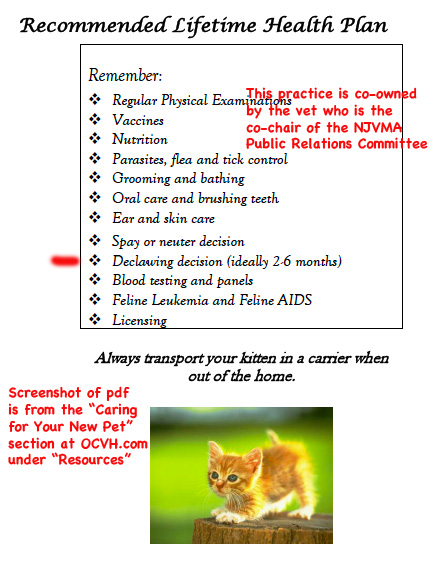
Here are some facebook ads from one of the NJVMA board member’s practice. When a cat owner asked about their ad, the board member, Dr Beeber says, “We try to talk people out of doing it the other way, it’s not as good.” He also said this when asked if his practice declaws cats, “We do, but we do it a special way. It’s a little bit more expensive , we do it with a laser. It takes away the pain and discomfort and they go home the same day.“
Here are some posts on a veterinary practice’s facebook page. (They offer free nail trims for dogs) 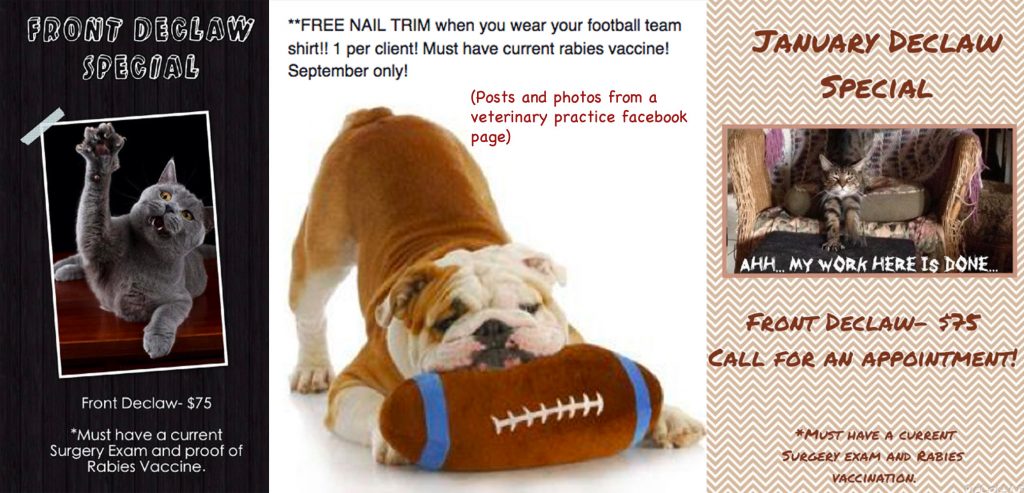
Here is an AAHA and AAFP Gold Level veterinary hospital that says they like to declaw their cats at 3 months old. [button href=”https://www.youtube.com/watch?v=M18mw6d00Yo” color=”red” newwindow=”yes”] Animal Hospital Advertising their Declaws[/button]
4) NJVMA’s Spokesvet Dr Yurkus, “The decision should be between vet and client, not regulated by the government.”
Veterinary medicine is regulated already, by the state veterinary practice act: New Jersey Statutes Annotated. Title 45. Professions and Occupations. Subtitle 1. Professions and Occupations Regulated by State Boards of Registration and Examination. Chapter 16. Veterinary Medicine, Surgery and Dentistry.
It is illustrative to look at that law. It states, “45:16-8.1. Practice defined:
Any person shall be regarded as practicing veterinary medicine within the meaning of this chapter, who, either directly or indirectly, diagnoses, prognoses, treats, administers, prescribes, operates on, manipulates, or applies any apparatus or appliance for any disease, pain, deformity, defect, injury, wound or physical condition of any animal, including poultry and fish, or who prevents or tests for the presence of any disease in animals, or who performs embryo transfers and related reproductive techniques, or who holds himself out as being able or legally authorized to do so.
The veterinarian may legally operate on an animal “for any disease, pain, deformity, defect, injury, wound or physical condition…” But nowhere does it state that veterinarians may cause injury to any animal in order to protect furniture, rugs, or drapes.
Declawing is not a medical decision. The American Veterinary Medical Association, the American Association of Feline Practitioners, and the American Animal Hospital Association agree that there is no medical benefit to the cat. Declawing is a quick-fix for a behavior problem that in nearly all cases is easily resolved by behavior modification or a dozen other humane, non-surgical alternatives.
5) NJVMA’s Spokesvet Dr Yurkus, “NJVMA is not pro-declaw, we are anti-euthanasia and anti-surrender.”
There is not and never has been any evidence whatsoever that banning declawing causes increased euthanasia of cats, although there is evidence that the opposite is true.
In fact, in the cities where declawing bans were passed at the end of 2009, the rate of cats coming into shelters (and, consequently, euthanasia rates) has gone down.
New York banned declawing in 2019. Here’s a couple letters we received from two shelter directors in those states.
“We are approaching the one year mark since the ban went into effect on July 22nd, 2019. We have not seen an increase in owner surrendered cats as a result of the ban. NSALA supported the ban and did not provide declawing services in our Pet Health Centers even before the ban went into effect. There are many other humane options to address the cat’s innate need to scratch. We have seen firsthand the damage caused by declawing both physically and behaviorally when owners want to surrender their declawed cats. We are happy to know that this practice has stopped in New York.
Joanne Yohannan, Senior Vice President of Operations, North Shore Animal League America”
Here’s another statement from Animal Care Centers of NYC .
“June 26, 2020
Anyone thinking that the declawing ban would lead to an increase in cat surrenders in New York City might be surprised to learn that ACC, the only open-admission shelter in NYC, has actually seen a decline in cat intake. At the same time we have seen a 25% increase in the amount of direct adoptions our organization has processed over the past year. The ban does not seem to have affected people’s desire to adopt cats in their natural state.
Katy Hansen
Director of Marketing and Communications
Animal Care Centers of NYC”
6) NJVMA’s Spokesvet Dr Yurkus, “Up to 72% of cats relinquished to shelters will be euthanized.”
That’s true, and tragic. However, it has nothing to do with the declaw status of any of those cats. Since declawed cats are frequently found in shelters, it is clear that declawing does not protect all cats from surrender or abandonment.
A recent study by the National Council on Pet Population Study and Policy (NCPPSP) and published in an issue of the Journal of Applied Animal Welfare Science (JAAWS), researchers went into 12 selected animal shelters in the United States for one year to find out why. The top 10 reasons for relinquishing cats are:
Moving, 8 percent;
landlord not allowing pet, 6 percent;
too many animals in household, 11 percent;
cost of pet maintenance, 6 percent;
owner having personal problems, 4 percent;
inadequate facilities, 2 percent;
no homes available for litter mates, 6 percent;
allergies in family, 8 percent;
house soiling, 5 percent;
incompatibility with other pets, 2 percent.
Here’s the story- AP story
In fact, declawing has been shown to increase the risk of cats being relinquished to shelters. Here is one example from two posts from the Paw Project – Indiana from November and December 2016. These are declawed cats that were relinquished to shelters because of behavioral issues. 
“After adjustment in a multivariate model, declawed cats were at an increased risk of relinquishment (OR=1.89;1.00-3.58); this reversal made the effect of declawing difficult to interpret. Among 218 cats relinquished to a shelter, more (44/84; 52.4%) declawed cats than non-declawed cats (39/134; 29.1%) were reported by owners to have inappropriate elimination (p=0.022).” [Patronek GJ, Glickman LT, Beck AM, et al. Risk factors for relinquishment of cats to an animal shelter. Journal of the American Veterinary Medical Association. 1996;209:582–588.]
Many declawed cats that are relinquished to shelters are euthanized before they are put up for adoption and there are many more that aren’t listed on petfinder.com.
Also, there are 89 DECLAWED cats in shelters/rescues that are within 50 miles of the NJVMA’s spokesvet’s animal hospital, Middletown Animal Hospital, in Middletown, New Jersey. Here are just a few of them. 
7) NJVMA’s Spokesvet Dr Yurkus, “There are a multitude of reasons why cats are surrendered due to inappropriate elimination (house soiling).”
True. Declawing is one of them.
8) NJVMA’s Spokesvet Dr Yurkus, “The problem is that declawing is seen as the way it was in the 60s and 70s.”
That’s because, except for the introduction of lasers and modern pain medications, declawing is STILL done the same way it was in the 60s and 70s.
See above references on behavior complications. Please note the dates; all but one (1988) are far beyond Dr. Yurkus’ claim of problems in the 70s and 80s: 1998, 2001, 2014, 2016.
9) NJVMA’s Spokesvet Dr Yurkus, “In this day and age, it is either a laser or a scalpel disarticulation. There is no muscle, no bone is cut.”
There are no muscles in the paw, but the third phalanx, which is a bone, is either cut (guillotine) or dissected out and removed (laser and scalpel). Declawing amputates bone, nerves, tendons, and ligaments.
The guillotine method is still widely used by about 30% of veterinarians. Because the claw grows directly from the bone, and there is no clear line of demarcation between germinal cells and ordinary bone, the bone must be removed.
10) NJVMA’s Spokesvet Dr Yurkus, “We use nerve blocks… non-steroidal pain killers… we use opiates… before, during, and after these procedures… So, we are doing this the right way.”
That’s good, but it’s not standard. It’s not mandatory. Many veterinarians provide adequate pain management, but this is far from universal.
A study from 2006 found that 12% of veterinarians were still not using any analgesics for any surgery. [Hewson J, Dohoo IR, Lemke KA. Perioperative use of analgesics in dogs and cats by Canadian veterinarians in 2001. Canadian Veterinary Journal. 2006 Apr;47:352-359.]
As of 2002, “An accurate estimate of the number of US veterinarians that aggressively treat pain in small animals is not currently available. Anecdotal evidence from talking with practitioners, new graduates, and students would suggest that the percentage is fairly low.” [Hellyer PW. Treatment of pain in dogs and cats. Journal of the American Veterinary Medical Association. 2002 Jul 15;221(2):212-215.]
In a survey published in 2016, the vast majority (82%) of veterinarians provided just 3-7 days’ worth of pain medications for clients to give at home—even though a previous study demonstrated that cats were painful for at least 12 days post-op (the entire term of the study). Horrifyingly, 1.1% of practitioners do not give any pain meds at all, before, during or after surgery; and 6.6% of practices (163 individual clinics) do not send ANY pain control with clients to give to the cats at home. [Ruch-Gallie R, Hellyer PW, Kogan LR. Survey of practices and perceptions regarding feline onychectomy among private practitioners. Journal of the American Veterinary Medical Association. 2016;249:291–298.]
It is important to note that this survey was conducted among members of the Veterinary Information Network, an online bulletin board and resource for vets. It costs a fair amount of money to belong to it. Only about 1/4 of practicing vets are members; and those who are, are the ones who are interested in keeping up with the profession, and in doing excellent medicine and surgery, according to modern practices.
Unfortunately, a great many veterinarians fall far below this standard.[button href=”https://citythekitty.org/declawed-without-pain-meds/” color=”red” newwindow=”yes”] Declawed With NO Pain Meds[/button]
11) NJVMA’s Spokesvet Dr Yurkus said a review of declaws studies shows that long-term lameness is only observed in 1% of cats and he has 3 studies to prove this.
Other studies disagree. If we talk about lameness only:
Twelve cats (13.6%) were classified as mildly lame at the long-term recheck. [Clark K, Bailey T, Rist P, et al. Comparison of 3 methods of onychectomy. Canadian Veterinary Journal. 2014 Mar;55:255-262.]
Lameness occurred more frequently in cats with disarticulation amputation (14/87, 16%) than in cats with bony amputation (4/80, 5%), possibly due to greater soft tissue trauma. Dehiscence (splitting open of a surgically closed wound) occurred in 22% and 12% of cats, respectively. [Martinez SA, Hauptmann J, Walshaw R. Comparing two techniques for onychectomy in cats and two adhesives for wound closure. Veterinary Medicine. 1993; 88:516-525.]
“43 cats showed lameness that persisted from 1-54 days. Long term follow up was done for 121/163 cats; one cat showed prolonged lameness (96 months) [Tobias KS. Feline onychectomy at a teaching institution: a retrospective study of 163 cases. Veterinary Surgery. 1994; 23:274-280.]
“…there is an exceptionally high complication rate, 50% in the immediate postoperative period (during hospitalization period) and 19.8% in the late postoperative period (the period following hospital discharge). (Cooper MA, Laverty PH, Soiderer EE. Bilateral flexor tendon contracture following onychectomy in 2 cats. Can Vet J. 2005 Mar;46(3):244-6) The authors suggest that tendon contracture, a newly-documented declaw complication, may have been seen previously but classified as “long-term” lameness.
12) NJVMA’s Spokesvet Dr Yurkus , “We are seeing more cats and doing less declaws… a survey of 100 practices found that the average is 9 declaws per year…” In his own practice “We’ve only done 2 this year. We don’t do that many because we train people not to do them.”
It’s great that Dr. Yurkus says he and his colleagues in his practice are following AVMA policy and educating people as to the alternatives. Unfortunately, that’s not the case for every New Jersey veterinary practice. Also, his own practice stated two times on a facebook post that they’ve done 4 declaws this year. In a telephone study, his own vet tech said that declawing is a regularly performed and common procedure at Dr Yurkus’ Middletown Animal hospital.

In a telephone survey of 110 veterinary practices in New Jersey, only 12 suggested any alternatives or even asked why the client wanted the cat declawed. Of the practices that declaw cats, 72% performed multiple declaws each month, which means a minimum of 24 per year. This same 72%, or 70 practices out of 97, stated they perform declaws “routinely”, “commonly”, or “frequently”—far more than 9 per year. [button href=”https://citythekitty.org/njdeclawstudy/” newwindow=”yes”] Declawing Study [/button]
The truth is, all reasons for non-medical declawing have non-surgical alternatives. There are many humane choices will still protect both human and feline health, as well as sofas and Persian rugs. We wonder how many of them Dr. Yurkus and his colleagues are actually discussing with their clients.
- Scratching posts, mats, corrugated cardboard, logs, softwood boards, sisal rope
- Training (yes, cats CAN be trained!)
- Regular claw-trimming
- Nail caps (SoftPaws, Soft Claws)
- Emery scratching boards (Emerycat)
- Double-sided sticky tape (Sticky Paws)
- Non-stick furniture protectors (Corner Savers, Fresh Kitty Furniture Protectors)
- Pet repellent sprays
- Access restriction (upside-down vinyl rug runner)
- Remote aversive devices (ScatMat, Ssscat)
- Phermones (Feliway)
- Furniture covers (blankets, towels—anything loose will not be appealing to your cat!)
- Those who absolutely insist that no cat of theirs will have claws, can adopt an already-declawed cat (there are many of them in shelters and rescues).
Despite Dr. Yurkus’ claims, studies show that the numbers of declawed cats are not declining, and have remained stable for several decades.
There is no evidence that the procedure is becoming less popular. It is at least maintaining itself in the population and may be making inroads in younger and younger kittens. For those vets seeing fewer and fewer declaw clients, those cats are simply being declawed elsewhere, with perhaps poorer surgical technique and the cheapest array of pain medications. Mills KE, von Keyserlingk MAG, Niel L. A review of medically unnecessary surgeries in dogs and cats. Journal of the American Veterinary Medical Association. 2016 Jan;248(2):162-171.
13) NJVMA’s Spokesvet Dr Yurkus, “There are people with children, people with blood disorders, people with transplants, who are on immune-therapy, or blood thinners, where a cat even playfully scratching them can lead to a life-threatening infection. These people can’t take those risks so they have to surrender their cats or they may not adopt a cat unless it can be declawed because of where they live, in a home or facility where the cat has to be declawed to be there.”
FACT: People with health issues should not declaw their cats. Declawing is not recommeded to protect humans from cat scratch fever.
The Center for Disease Control (CDC), the US Public Health Service, the National Institutes of Health, (NIH), American Cancer Society, National Hemophilia Foundation, and infectious diseases experts, AAHA, AAFP, and the AVMA do not recommend declawing cats for any human health reason or to protect humans from scratches.
Things that people can do to protect themselves from scratches.
Trim your cat’s nails, use common sense and care when playing with your cat, keep your cat indoors, and wash scratches with soap and disinfectant.
See your veterinarian for the proper treatment if your cat has fleas. Cat Scratch Fever is caused by fleas.
Please click on this button for more information about human health issues and declawing. Declawing and human health
In Great Britain, all the countries of the European Union, Israel, New Zealand, and Australia, there are also such people, but declawing is illegal in all of them. No physicians’ organization or even the CDC recommends declawing.
As to housing, federal guidelines specifically allow cats in federally subsidized housing, and do not require declawing. Some landlords do require it, but moving into such a place is always a choice. In California and Rhode Island, it is against the law for landlords to require declawing as a condition of having a cat. If declawing becomes illegal, lease clauses requiring declawing will become invalid: problem solved.
It should be noted that dogs (and rodents, and rabbits, and turtles, and other pets) also have claws, they frequently scratch up people, floors, and furniture, but nobody is declawing dogs or any other animal.
There are many humane alternatives that do not involve amputating cats’ toes.
Re-homing a cat is not the worst thing that can happen. The risk of serious pain for the rest of a cat’s life must be taken into account. Right now there are 2,826 declawed cats sitting in shelters on petfinder. Declawing isn’t saving cats’ lives, and it’s not keeping them in their homes. Re-homing doesn’t mean failure, and it should be considered a valid option and not equivalent to death.
Four to 10 % of shelter adoptions fail; and about 4% of cat owners say they would get rid of their cat if it couldn’t be declawed. Not every cat is a perfect match; there are plenty of incompatible adoptions. If re-homing is necessary to save a cat from a potential lifetime of pain, that may be the best alternative for that cat.
14) NJVMA’s Spokesvet Dr Yurkus, “Some groups supporting this bill say that declawing always results in pain or negative consequences… this is absolutely false.” (Displays a study showing a picture of the declawing procedure and claims that it’s not done that way any more.)
Anatomical Changes in Declawed Cats
The most recent study of post-surgery problems also reported the highest rates of pain-related complications: up to 23% of cats with ongoing lameness, and 42.3% of cats showing signs of pain when their paws were handled. Owners also reported long-term behavioral changes in cats following declawing (house soiling); resistance to paws being handled; or increased incidence or severity of biting), compared with the same cats’ behavior before the procedure. [Clark K, Bailey T, Rist P, et al. Comparison of 3 methods of onychectomy. Canadian Veterinary Journal 2014;55:255–262.]
One common long-term complication of onychectomy is claw regrowth, with rates reportedly from 3.4% to 15.4%, depending on the study and the method of claw removal. One study found that claw regrowth was more common with use of a nail clipper than with use of a scalpel or laser (15.4% vs 6.5% and 3.4%); but claw regrowth occurred regardless of technique. This is the so-called “pebble in the shoe” issue. All the time that claw is growing—up to 15 years—it is causing pain. Other long-term complications include persistent lameness and signs of chronic pain. [Clark K, Bailey T, Rist P, et al. Comparison of 3 methods of onychectomy. Canadian Veterinary Journal 2014;55:255–262.]
In fact, there is even such a thing as “Chronic Pain Syndrome of Onychectomy [Declawing]” A noted veterinary pain specialist has found that “Feline patients who have had onychectomy (declaw) may experience chronic pain. Owners of such cats usually report one of several concerns, the most common of which is fear that the cat is still in pain, especially in the fore paws, because it seems to walk very lightly on those feet, as if walking on nails or glass. Another common concern is behavioral changes, which may include decreased activity, decreased appetite, or increased aggression. The inciting cause for these presentations within days to months to years is usually the lack of adequate acute pain control in the immediate postoperative period.” Yet the veterinary profession has yet to acknowledge the existence of such a syndrome. [Gaynor JS. Chronic pain syndrome feline onychectomy. NAVC Clinician’s Brief. April 2005.]
15) NJVMA’s Spokesvet Dr Yurkus compares declawing to neutering and says. “The discomfort level is no more than in a neuter than it is in the declaws that are done properly.” [button href=”https://citythekitty.org/painful-truth-declawing/” color=”red” newwindow=”yes”] Pain and Declawing [/button]
Here is how the NJVMA rated declawing in 2007 in their NJVMA Animal Welfare Task Force. Guidelines for Preventing, Recognizing, and Treating Pain in the Hospital Setting.
“Moderately Severe to Severe:” onychectomy. It was in the same category as cancer pain, fracture repair, limb amputation and many other painful procedures.
Here’s how they rated neutering, “Mild to Moderate: ovariohysterectomy (OVH) (young animals), castration.”
When cats start walking on their balls then we will start believing Dr Yurkus that declawing isn’t more painful than neutering.
Meanwhile, the American Association of Feline Practitioners’ policy on declawing states:
“Physically, regardless of the method used, onychectomy causes a higher level of pain than spays and neuters. Patients may experience both adaptive and maladaptive pain; in addition to inflammatory pain, there is the potential to develop long-term neuropathic or central pain if the pain is inadequately managed during the perioperative and healing periods.” [AAFP Policy Statement on Declawing, 2007.]
16) NJVMA’s Spokesvet Dr Yurkus and Veterinarians like to point to the surveys of clients after having their cats declawed. Most clients say they are pleased with the outcome of the surgery.
Photos posted on Instagram by cat owners. 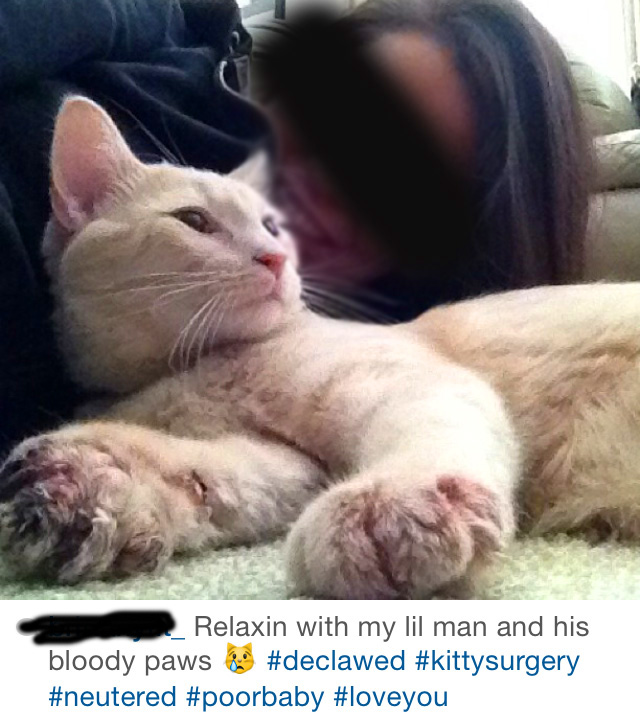
However, long-term follow-up is lacking in the vast majority of cases. How pleased will those clients remain if their cat is still obviously painful in 6 months, or 2 years?
How pleased will they be if they’re in the unlucky 15% whose cats regrow their claws, requiring more surgery to correct it?
How pleased will they be if they are among the 33% whose cats develop a behavior problem, like biting or peeing on the bed? Quite a few clients do become displeased at some point, because a lot of older declawed cats are being surrendered to shelters. In fact, it’s likely that clients who are intolerant of scratching behavior to the point of having their cat declawed will also be intolerant of any behavioral complications that may arise months or years later.
Also if you go to facebook and in the search bar at the top, type in the word “declaw”, and click on “Latest”, you will see a post about every minute, of a cat owner who is throwing away or trying to give away their declawed cat. There have been a total of 3644 declawed cats in the last 6 months that are being given away by their owners. (June 2016- Dec. 2016)

